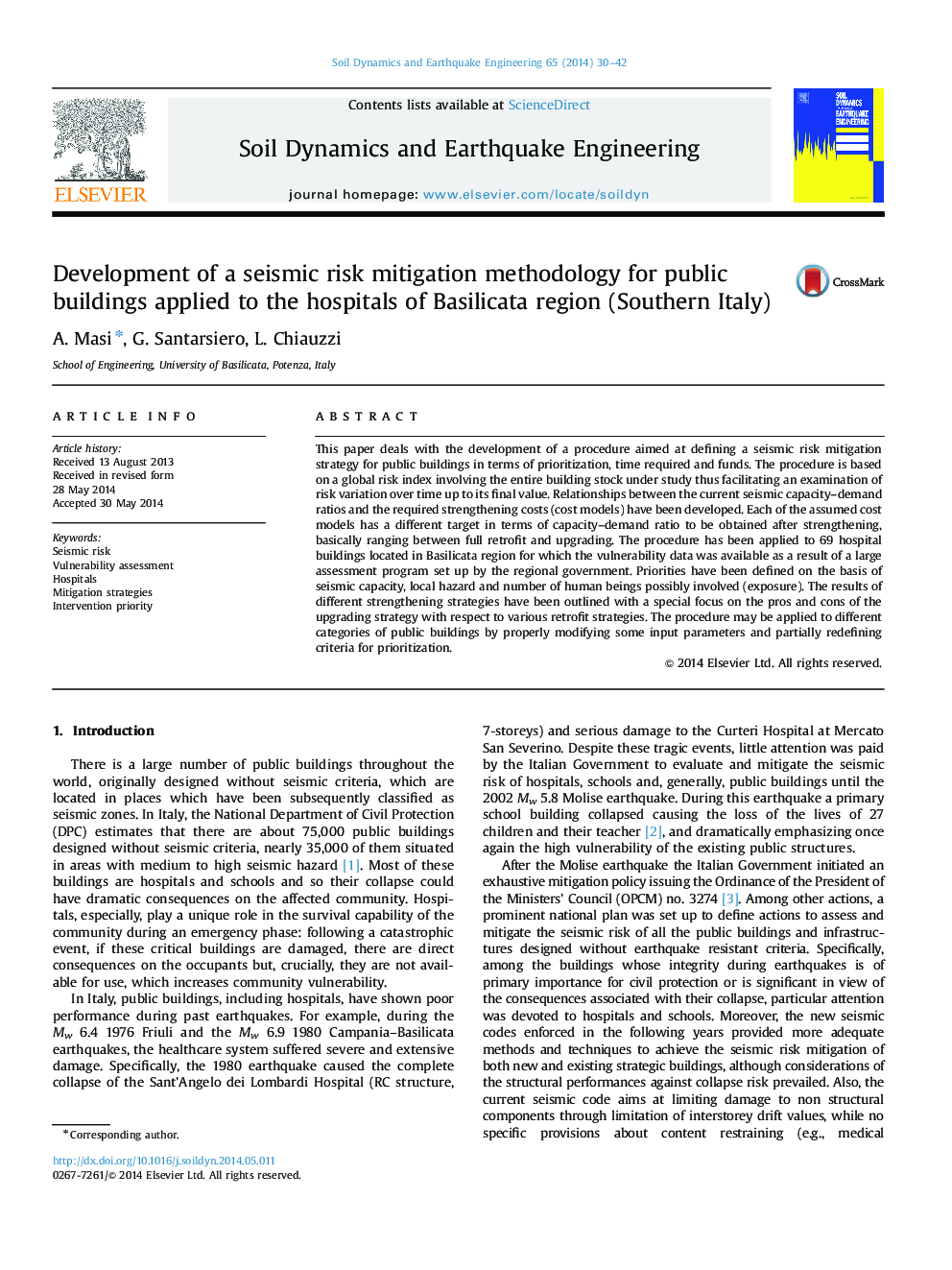| کد مقاله | کد نشریه | سال انتشار | مقاله انگلیسی | نسخه تمام متن |
|---|---|---|---|---|
| 6772517 | 512778 | 2014 | 13 صفحه PDF | دانلود رایگان |
عنوان انگلیسی مقاله ISI
Development of a seismic risk mitigation methodology for public buildings applied to the hospitals of Basilicata region (Southern Italy)
ترجمه فارسی عنوان
توسعه روش شناسی ریسک زلزله برای ساختمان های عمومی که به بیمارستان های منطقه باسیلیکاتا (جنوب ایتالیا) اعمال می شود
دانلود مقاله + سفارش ترجمه
دانلود مقاله ISI انگلیسی
رایگان برای ایرانیان
کلمات کلیدی
ریسک لرزه ای، ارزیابی آسیب پذیری، بیمارستان ها، استراتژی های کاهش، اولویت مداخله،
ترجمه چکیده
این مقاله به توسعه یک روش برای تعیین یک استراتژی کاهش خطر لرزه ای برای ساختمان های عمومی از لحاظ اولویت بندی، زمان لازم و بودجه می پردازد. این روش بر اساس یک شاخص خطر جهانی شامل کل سهام ساختمان تحت مطالعه است، بنابراین تسهیل بررسی تغییرات خطر در طول زمان تا ارزش نهایی آن است. روابط بین نسبت های تقاضای تقاضای لرزه ای فعلی و هزینه های تقویت لازم (مدل های هزینه) توسعه یافته است. هر یک از مدل های هزینه فرض شده دارای اهداف متفاوت از نظر نسبت ظرفیت تقاضا است پس از تقویت، به طور عمده بین ارتقاء کامل و کامل قرار می گیرد. این روش برای 69 ساختمان بیمارستان واقع در منطقه باسیلیکاتا مورد استفاده قرار گرفته است که اطلاعات مربوط به آسیب پذیری در نتیجه یک برنامه ارزیابی بزرگ توسط دولت منطقه ای در دسترس بوده است. اولویت ها براساس ظرفیت لرزه ای، خطر محلی و تعداد انسان هایی که ممکن است در معرض قرار گیرند، تعریف شده است. نتایج استراتژی های تقویت مختلف با تمرکز ویژه ای بر جوانب مثبت و منفی استراتژی ارتقاء با توجه به استراتژی های تکمیلی مختلف مشخص شده است. این روش می تواند به دسته های مختلف ساختمان های عمومی با اصلاح برخی از پارامترهای ورودی و تغییر معیارهای اولویت بندی به طور جزئی تغییر یابد.
موضوعات مرتبط
مهندسی و علوم پایه
علوم زمین و سیارات
مهندسی ژئوتکنیک و زمین شناسی مهندسی
چکیده انگلیسی
This paper deals with the development of a procedure aimed at defining a seismic risk mitigation strategy for public buildings in terms of prioritization, time required and funds. The procedure is based on a global risk index involving the entire building stock under study thus facilitating an examination of risk variation over time up to its final value. Relationships between the current seismic capacity-demand ratios and the required strengthening costs (cost models) have been developed. Each of the assumed cost models has a different target in terms of capacity-demand ratio to be obtained after strengthening, basically ranging between full retrofit and upgrading. The procedure has been applied to 69 hospital buildings located in Basilicata region for which the vulnerability data was available as a result of a large assessment program set up by the regional government. Priorities have been defined on the basis of seismic capacity, local hazard and number of human beings possibly involved (exposure). The results of different strengthening strategies have been outlined with a special focus on the pros and cons of the upgrading strategy with respect to various retrofit strategies. The procedure may be applied to different categories of public buildings by properly modifying some input parameters and partially redefining criteria for prioritization.
ناشر
Database: Elsevier - ScienceDirect (ساینس دایرکت)
Journal: Soil Dynamics and Earthquake Engineering - Volume 65, October 2014, Pages 30-42
Journal: Soil Dynamics and Earthquake Engineering - Volume 65, October 2014, Pages 30-42
نویسندگان
A. Masi, G. Santarsiero, L. Chiauzzi,
